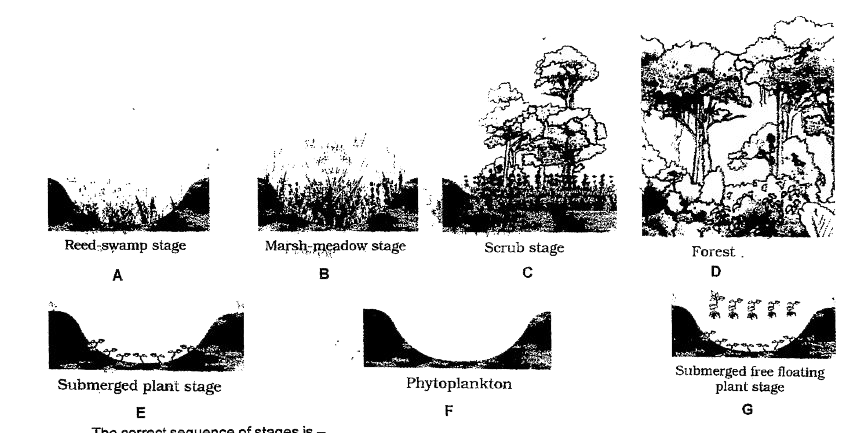Describe primary succession in water .
Step-by-Step Text Solution for Primary Succession in Water
1. Definition of Succession:
- Ecological succession refers to the gradual and fairly predictable changes in species composition in a given area over time. It occurs in response to changing environmental conditions and leads to the establishment of a climax community.
2. Understanding Primary Succession:
- Primary succession occurs in areas where no living organisms previously existed. This can include barren rocks, newly formed ponds, or areas created by volcanic activity, such as newly cooled lava.
3. Example of Primary Succession in Water:
- A newly created pond serves as a good example of primary succession in an aquatic environment.
4. Pioneer Species:
- The first organisms to colonize the newly formed aquatic environment are known as pioneer species. In the case of a pond, these are typically phytoplankton.
5. Stages of Succession:
- As time progresses, the following stages of succession occur:
- Phytoplankton Stage: The initial colonizers, which are microscopic plants that float in the water.
- Submerged Plant Stage: As conditions improve, submerged aquatic plants begin to establish themselves.
- Free-Floating Plant Stage: Next, free-floating angiosperms (flowering plants) appear.
- Reed-Swamp Stage: This stage is characterized by the growth of reed plants along the edges of the pond.
- Marsh-Meadow Stage: The environment transitions to a marshy area with grasses and other herbaceous plants.
- Scrub Stage: Shrubs and small trees begin to grow, further stabilizing the ecosystem.
- Forest Community: Finally, a mature forest community is established, which represents the climax community where species composition stabilizes and changes minimally.
6. Climax Community:
- The climax community is the final, stable community that results from the succession process. In the context of primary succession in water, this would be a well-established forest surrounding the pond, where no further significant changes in species composition occur.
- Ecological succession refers to the gradual and fairly predictable changes in species composition in a given area over time. It occurs in response to changing environmental conditions and leads to the establishment of a climax community.
- Primary succession occurs in areas where no living organisms previously existed. This can include barren rocks, newly formed ponds, or areas created by volcanic activity, such as newly cooled lava.
- A newly created pond serves as a good example of primary succession in an aquatic environment.
- The first organisms to colonize the newly formed aquatic environment are known as pioneer species. In the case of a pond, these are typically phytoplankton.
- As time progresses, the following stages of succession occur:
- Phytoplankton Stage: The initial colonizers, which are microscopic plants that float in the water.
- Submerged Plant Stage: As conditions improve, submerged aquatic plants begin to establish themselves.
- Free-Floating Plant Stage: Next, free-floating angiosperms (flowering plants) appear.
- Reed-Swamp Stage: This stage is characterized by the growth of reed plants along the edges of the pond.
- Marsh-Meadow Stage: The environment transitions to a marshy area with grasses and other herbaceous plants.
- Scrub Stage: Shrubs and small trees begin to grow, further stabilizing the ecosystem.
- Forest Community: Finally, a mature forest community is established, which represents the climax community where species composition stabilizes and changes minimally.
- The climax community is the final, stable community that results from the succession process. In the context of primary succession in water, this would be a well-established forest surrounding the pond, where no further significant changes in species composition occur.
Topper's Solved these Questions
- ECOSYSTEM BOOK - MODERN PUBLICATIONCHAPTER - ECOSYSTEM EXERCISE - REVISION EXERCISES (IV. SHORT ANSWER TYPE - II QUESTIONS) (B. QUESTIONS FROM CBSE EXAMINATIONS)
11 Videos
- ECOSYSTEM BOOK - MODERN PUBLICATIONCHAPTER - ECOSYSTEM EXERCISE - REVISION EXERCISES (VI. LONG ANSWER TYPE QUESTIONS)(A. QUESTIONS FROM STATE BOARD EXAMINATIONS)
19 Videos
- ECOSYSTEM BOOK - MODERN PUBLICATIONCHAPTER - ECOSYSTEM EXERCISE - REVISION EXERCISES (III. SHORT ANSWER TYPE - I QUESTIONS) (B. QUESTIONS FROM CBSE EXAMINATIONS)
16 Videos
- BIOTECHNOLOGY AND ITS APPLICATIONSBOOK - MODERN PUBLICATIONCHAPTER - BIOTECHNOLOGY AND ITS APPLICATIONSEXERCISE - CHAPTER PRACTICE TEST (SECTION - E)
2 Videos
- EVOLUTIONBOOK - MODERN PUBLICATIONCHAPTER - EVOLUTIONEXERCISE - CHAPTER PRACTICE TEST (SECTION-D)(CASE-BASED SHORT ANWER )(THREE MARK EACH)
2 Videos
Similar Questions
The different stages of primary succession in water are represented below . Fill the gaps :
(a) Phytoplankton (b) .............. (c) Submerged free floating plants (d) ..................
(e) .............. (f) Shrub stage (g) ..............
View SolutionName the pioneer species that invade in primary succession on bare rock and in water.
View Solution
Knowledge Check
Following are the different stages in the primary succesion in water body

The correct sequence of stages is -AF - E - G - A - B - C - DBA -C - E - G - B - D - FCA -G - F - B - C - D - EDG - F - E - D - C - B -AThe sequence of communities of primary succession in water is
Aphytoplankton, sedges, free-floating hydrophytes, rooted hydrophytes, grasses and tressBphytoplankton, free floating hydrophysis, rooted hydrophytes, sedges, grasses and treesCfree-floating hydrophytes, sedges, phytoplankton, rooted hydrophytes, grasses and treesDphytoplankton, rooted submerged hydrophytes, floating hydrophytes, reed swamp, sedges, meadow and trees.The sequence of communities of primary succession in water is
Aphytoplankton, sedges, free-floating hydrophytes, rooted hydrophytes, grasses and trees.Bphytoplankton, free-floating hydrophytes, rooted hydrophytes, sedges, grasses and trees.Cfree-floating hydrophytes, sedges, phytoplankton, rooted hydrophytes, grasses and trees.Dphytoplankton, rooted submerged hydrophytes, floating hydrophytes, reed swamp, sedges, meadow and trees.
